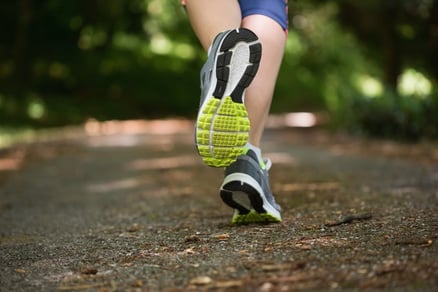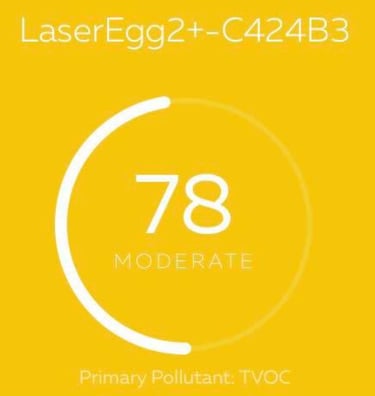Don't Let Bad Air Quality Get in the Way of Your Workouts

When you're hyped up and ready to make your workout count, air quality shouldn’t stop you from staying fit and doing the sports you love. From running, cycling, or training for a marathon, don’t let bad air quality get in the way of your active lifestyle (or your long-term health, for that matter). This is a complete guide to help you understand how to optimize your workout routine when you live in an area impacted by pollution. There’s a lot to cover; buckle in.

You will learn:
- Terms: So, what exactly are you breathing when you step outside and lace up? Understanding the terms associated with air quality is the first step in protecting your air and keeping your lungs safe during workouts.
- Tactics: If you’re going to meet your training goals, you need to be able to effectively maintain your fitness schedule. Learning simple and effective tactics will help you keep focused on your goals (instead of worrying about pollution).
- Technologies: Any regular workout can benefit from keeping tabs on training through the use of tech. You can track calories burned, distances covered, and new personal bests. But, are you using the right tech to track your air?
Terms To Know — Air Pollution & Workouts
As soon as your workout starts, you feel it; shortness of breath. Your throat gets itchy and your eyes start watering. And then there’s a headache. It’s mild at first, but it is getting worse. What’s happening?
You’re body is reacting to pollution. If you live in an area that suffers from bad air quality, there are steps you can take to protect yourself during your workouts. To do that, you need to start by learning some specific terms about pollution and air quality. Below are the three main pollution terms you need to know.
1) Particulate Matter (AKA PM2.5 & PM10)
PM is an abbreviation for particulate matter. You may have read about it in the news or heard someone refer to it as smog. The associated number stands for the size of the particles which are measured in microns. For example, PM10, sometimes referred to as coarse particulate matter, is made up of particles that are 10 microns or less in diameter. PM2.5, sometimes referred to as fine particulate matter, is made up of particles that are 2.5 microns or less in diameter.
To give you an idea of what that really means, the width of a single hair is 70 microns. The width and diameter of a bacterial cell is 5 microns.
PM2.5 and PM10 both come from man-made sources (such as the combustion of fossil fuels and burning wood), but can also come from natural sources like wildfires and volcanic eruptions. Their names sound similar, but they are vastly different in terms of how they can impact air quality. When PM10 enters your lungs, it tends to stop there because your body produces mucus to expel these particles. However, when PM2.5 enters into your lungs, the particles are so small they can cross the lung barrier and can enter your bloodstream.
When you hear that PM2.5 levels outside are high, that means that you may be breathing sulfates, nitrates, ammonia, sodium chloride, and black carbon molecules. These fine particles can enter your body and reach all of your major organs. Over the short term, this can cause headaches, a sore throat, and inflammation. Over a long period of time, this can cause serious health problems. According to the World Health Organization’s International Agency for Research on Cancer, pollution is directly linked with higher incidences of cancer.
In a study that appeared in the Lancet, researchers collected data to analyze the long-term effects of pollution (between 1995-2015). They found that higher rates of pollution are correlated with incidences of ischemic heart disease, cerebrovascular disease, chronic obstructive pulmonary disease, and lung cancer.
Safety Guidelines for PM Concentrations
The World Health Organization has outlined specific safety guidelines for PM concentrations in the air:
Coarse Particulate Matter (PM10)
- 10 μg (micrograms)/m3 (cubic meter) annually
- 25 μg/m3 average over 24 hours
Fine Particulate Matter (PM2.5)
- 20 μg/m3 annually
- 50 μg/m3 average over 24 hours
Many cities, especially megacities in India and China, can have PM levels that are 5-7 times above the recommended safe limits. The main takeaway here is that this gunk is not stuff you want to be breathing in when you’re training hard.
2) Total Volatile Organic Compounds (TVOCs)

Total Volatile Organic Compounds (TVOCs) are gasses emitted by compounds that are often found in common household items. You can find them in aerosols, air fresheners, cosmetics and cleaning products. They are dangerous because they can accumulate indoors and are known to irritate your airways when inhaled. The effects of TVOCs will depend on their chemical makeup, the amount of exposure, and the surrounding ventilation.
The best ways to protect yourself during workouts are to avoid chemicals and increase airflow whenever possible.
3) Air Quality Index (AQI)
This index is a color-coded and numerical scale that measures air quality. It is a way for governments to communicate the level of pollution in the air and the health hazards associated with it. Every country has its own AQI values, standards, and scales. Government agencies can send out warnings based on the AQI levels for that day.
These values are updated in real-time and can fluctuate dramatically in some places. In Beijing, for example, it’s not unusual to have values in a healthy range one day, and then suddenly swing to very unhealthy within a few hours.
Curious to understand more about other air pollution terms? To learn about different types of pollutants that are affecting the AQI in your area, check out our wiki.
Tactics To Protect Yourself From Air Pollution During Workouts
Now that you are armed with the right terminology, here’s what you can do to keep pollution from impacting your fitness routine. Below are 7 ways to protect yourself from air pollution during workouts.
1) Check the AQI levels before workouts
There are many ways to track the air quality in your local area. If you are in the United States, you can check out the EPA’s AirNow website. It gives you the current AQI for the local area, PM2.5 and PM10 levels, and an air quality forecast for the next day. You can also use the World Air Quality Project’s website, which has data for the U.S. and for thousands of cities around the world.
If you want to know the air quality of where you are standing right now, you can get an air quality monitor. Albeit clunky, some of these devices are portable and help you accurately measure pollutants in the air. When you understand what’s happening with the air quality is outside, you’ll know when it’s optimal to go for a run or get on your bike.
2) Plan your workouts in advance
We know that air quality varies throughout the day. The air is usually cleanest in the morning and gets worse in the afternoon. Since AQI forecasts can be days in advance, it is safer to plan ahead.
It’s important to understand how the weather can affect air quality as well. Bright, sunny days often have the worst air quality. Hot air and sunshine can make pollutants undergo chemical reactions which create higher concentrations of pollutants in the air causing smog.
Rain and wind can wash and clear away polluted air. After it rains, the moisture in the ground prevents particles from being kicked up into the air. Also, when rain droplets fall, they merge or coagulate, with particles in the air. Atmospheric scientists at MIT observed this phenomenon in controlled laboratory conditions and observed that smaller droplets are more efficient at attracting particles from the air. When you’re training hard, it’s best to plan for gloomy days as the best days to workout.
3) Pick workout areas with plenty of greenery

A source of PM2.5 is fossil fuel combustion. In other words, vehicle exhaust. Even when the AQI for the day is good, you still don’t want to be near vehicle exhaust when you’re out for a run. If you’re going to train outside regularly, take the time to search around for parks, trails, and other areas with plenty of trees and grass. Use a portable air monitor if you want to be extra cautious.
4) Use the right workout gear
If you have to take your workout outside when pollution levels are high, you should get a face mask. You probably won’t need to use them every day, but you should keep one handy if the AQI is higher than you expected. While there are many benefits of using a pollution mask during workouts, it’s important that the mask is of high quality.
The types you want are either P-95 or P-99 masks (not to be confused with surgical masks). The name refers to the percentage of particles they are able to block—for example, P-95 can block 95% of particles, and P-99 can block up to 99% of pollution particles. These are lightweight, affordable, and some can be reused.
5) When in doubt, take your workout indoors

There will be days when going outside simply isn’t an option. While you’ll likely survive working out on a polluted day (with a face mask), you will be much safer if you avoid the risk. Workouts can take place anywhere, including your home or an indoor gym.
You’ll have to do some research to find out about a gym’s air filters and cleaning products. Look for gyms that value clean air:
We want to provide an environment for people to learn and better themselves. That means providing top quality coaching and having a great space with clean air to train in. Using air quality monitors lets us demonstrate to our customers that we are taking their health seriously and can show them our real time air quality.
Tom, Owner of CrossFit Slash (Beijing, China)
If you have real doubts about the gym’s air quality, bring your own portable air quality monitor to check it out.
6) Use the right workout fuel
Fitness and good nutrition go hand-in-hand. But good nutrition doesn’t just fuel your workouts, it can also help protect you against the negative effects of air pollution.
A study done at Columbia University’s Mailman’s School of Public Health showed how B vitamins could protect against genetic damage caused by PM2.5. Over the course of four weeks, volunteers who took B vitamin supplements (2.5 mg folate, 50 mg of B6 and 1 mg of B12) experienced less genetic damage from pollution compared to volunteers who took placebos.
The best sources of B vitamins are legumes, green leafy vegetables, fish, beef liver, potatoes, beef, eggs, and dairy products.
7) Improve home workouts with better indoor air quality
According to the EPA, indoor air quality can often be 2-5 times worse than outside. When you workout, you breathe faster and deeper. Your lungs are quickly shuttling oxygen throughout your entire body. This means that you will have to take steps to get your indoor air quality right if you’re going to work out at home. Keep the windows closed on polluted days and consider buying an air filter.
Technology to Protect Yourself From Air Pollution During Workouts
By now it should be really clear how air quality impacts your lungs. It needs to be taken into consideration when creating your workout plan. We’ve covered many simple steps you can take as a precaution, but if you want to truly understand what’s in your air and effectively filter it out, you’re going to need the right tools. New technologies can be used to filter both indoor and outdoor pollutants. They are key to automating your air quality and helping you optimize your workout routine.
AQI apps
You need a reliable source of information about your local AQI. There are many (free) apps that help you quickly find local AQI data from your smartphone or smartwatch. They enable you to check the current air quality levels wherever you are.
Air filters
If heavy pollution is making it really hard to get outside, the most important thing you can do is invest in a good air purifier that uses HEPA (High-Efficiency Particulate Air) filters. This is because these filters capture particles as small as 0.3 microns. Some premium brands are able to catch particles as small as 0.003 microns. It is your main weapon in a fight for clean air. Learn more about how HEPA filters work.
Air quality monitors
Many people don’t realize that a gentle breeze can disrupt the air inside your home and fill it with outdoor pollution. Sometimes, you might have to check for cracks and gaps in and around your building to ensure that outdoor air isn’t able to creep inside. Use a portable air quality monitor if you think that contaminated air may be seeping in.
In particularly polluted areas, air filters tend to get overworked and as a result, their sensors can get clogged. When that happens, they aren’t able to properly filter the air because they can’t effectively read the pollution levels. This is a problem you want to avoid during intense workouts.
Air automation
Finally, you can also automate your indoor air quality by integrating your tech devices with IFTTT (If This, Then That) applets. For example, an air purifier can be set to automatically turn on when the air quality levels hit a certain threshold, or you can send alerts to your phone when the filters in your air purifier hit a certain age. Below are examples of different air applets available on IFTTT:
To Recap
You would never drink dirty water when you’re training. So why would you breathe dirty air? Pollution is something that impacts your lungs and you need to be aware of it during your workouts. The first step is to start learning about different types of pollutants that are affecting the AQI in your area.
Next, you need to use tactics during your workouts that will ensure you are breathing clean air. Here’s a recap on what you can do to keep it from impacting your fitness routine:
- Check daily AQI levels in your area — There are plenty of free apps that will provide real-time data you can access from your phone or smartwatch.
- Plan your workouts at specific times — Air pollution is better at certain times of day and is impacted by the weather. Plan accordingly.
- Look for workout areas with lots of greenery — It should go without saying, but try to avoid places near heavy car traffic so that you don’t breathe in fumes.
- Have the right gear — Be prepared for polluted days by keeping a face mask on hand.
- Head indoors on polluted days — Find a gym or workout area that you know will have clean and healthy air. This might require some research on your part.
- Eat the right foods — B vitamins can help mitigate the effects of PM2.5.
- Make home workouts count — When it’s really polluted outside, make sure to keep the windows closed and consider buying an air filter.
If you live in a polluted area, you can still have an athletic lifestyle. It can feel overwhelming to have to track another set of metrics, considering that you probably already track your daily calories, steps, and sleep. That said, knowing what you’re breathing is just as important. With apps, websites, and the right tech, accessing this data is now simpler than ever.
Article by Christine Johnson



Dejar un comentario